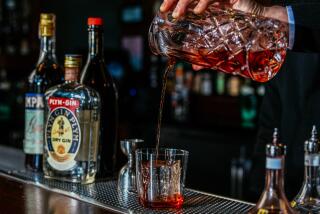Separating Brandy Fact, Fiction : An Exercise in Demythologizing Some Wine Lore
- Share via
The lore of Cognac and other fine brandies (such as Armagnac) is built on some facts and a lot more myths. Here are a few of the myths:
Myth: The best way to get the aroma of Cognac or brandy out of the glass is to warm it over a flame.
Fact: Cognac is, at its best, a delicate and sensuous elixir that first is a feast to the eyes, then to the nose and then the palate. Aroma is a huge part of that experience, but forcing the aroma out by heating it with a flame is far more than you need. In fact, such a tactic could be painful. The best way to get at that delicacy is to cup the bowl of the snifter in your hand and allow the warmth of your hand to warm the liquid enough to permit it to escape.
Myth: To get the best aroma out of a snifter of Cognac, you swirl it and stick your nose inside the glass.
Fact: All that technique does is get your sinuses a whiff of alcohol. Cognac is best sniffed, after a swirl, with the nose a few inches above the snifter, to permit the great nuances to combine with air and thus be delicate rather than intense.
Myth: Cognac doesn’t improve once it’s bottled.
Fact: There is probably no marked improvement in a year or two in the bottle, but many people believe that great brandy improves with much time in bottle. The aging permits the liquid to “knit,” and become more intense. Sacramento wine merchant Darrell Corti recalls that the late Dr. James Guymon of UC Davis was “convinced that all alcohol improves with time in bottle.” And Corti recalls that Ken Kew, former owner of Esquin Imports in San Francisco, once said that the greatest Cognac was one “aged 25 years in cask and 15 years in bottle.”
Myth: A bottle of Cognac or brandy doesn’t change once it’s opened.
Fact: Once opened, Cognac oxidizes just like most fine beverages. A great Cognac, like a fine wine, should be protected from air. To preserve half a bottle of fine Cognac, put it into a half bottle with no air between the liquid and the stopper.
Myth: All the color in brandy comes from aging in oak, so the darker it is, the longer it’s been in oak.
Fact: Many brandies have caramel added to give the impression of long aging.
More to Read
Eat your way across L.A.
Get our weekly Tasting Notes newsletter for reviews, news and more.
You may occasionally receive promotional content from the Los Angeles Times.








